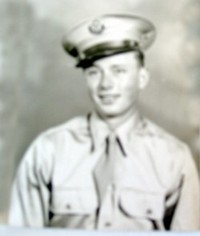Don Feurig and the Office of Strategic Services in WWII
 By
By
Bill Collar
During the past year, I’ve had the opportunity to interview Don and Frieda Feurig and Roy Puls. The June Seymour History Bulletin featured Roy’s recollections with an emphasis on early area baseball. The focus of this article is Don’s experience in WWII when he was in the OSS.
Don was just 13 years old his father passed away. When WWII started he was helping support his mother and was exempt from the draft. As the war heated up, he was drafted in 1943 and sent to Fort Sheridan, IL and then to Alabama for training in chemical warfare. Don had been working for Ed Babbitt in the plumbing business in Seymour, and the army needed pipefitters.
After a short time, he was sent to Washington, DC to join what would become the Office of Strategic Services (OSS), the predecessor of the CIA. The OSS was established by President Roosevelt to collect and analyze strategic information required by the military. The program was under the direction of WWI hero, General William (Wild Bill) Donovan. After Congress allocated the money, the OSS took over the Congressional Country Club outside of Washington, DC for training. Seymour’s Don Feurig was serving his country in a chemical weapons lab in the basement of a former country club as one of the first enlisted members of the OSS. One of the big projects was to make a grenade shaped like a baseball so American youths could throw it with greater accuracy. Eventually, Don’s responsibility was to run the switchboard.
After a year and a half, he was sent to Catalina Island, off the coast of southern California. The OSS leased facilities there to coordinate an espionage program to obtain information that would be used against the Japanese after radio stations were established on the Aleutian Islands. The plan was to jam the enemy radio signals and transmit propaganda, similar to what “Tokyo Rose” was doing for the Japanese.
The OSS had in their possession a Japanese prisoner of war who agreed to transmit information back to Japan and ships at sea. Don was sent to the Biltmore hotel in Los Angeles and then to the Presidio in San Francisco. His duty was to pick up the Japanese defector and transport him to a studio to make anti-Japanese recordings. The prisoner changed into civilian clothes and Don transported him almost every day. One day the car didn’t show up so Don had to take him for a walk. Don recalls walking through a Chinese laundry with his Japanese prisoner and the Chinese turned their backs to him.
While in San Francisco, Don saw the Secretary of State Stettinius using the side door of the St. Francis Hotel. He knew something big was going on because there was a Russian Ship in the harbor and the contingent of Russian statesmen were noticeable on the streets of the city. A short time later, he was shipped to Calcutta, India. From there he traveled over the Himalayas to China. Not knowing where he was going next, Don was relieved when the war ended and he was shipped home. He came home via the Suez Canal in 1945 completing a circumnavigation of the globe.
Don was thrilled to arrive back in Seymour and he got a job with Seymour Hardware working for John Bunkelman and Elbridge Boyden. He was a good friend of Emil Gosse, who returned from service in Europe. He got to know Emil’s sister, Frieda, quite well and on November 28, 1946 they were married. Additional recollections from Don, Frieda, and Roy are included in the bullet points. Several will be covered in later issues.
• The 1933 milk strike involved a huge protest at the fairgrounds.
• Seymour was a prosperous city in the 1930’s. On Friday nights it was so crowded it was difficult to get through town.
• Four passenger and four freight trains passed through town daily. Many people traveled by rail.
• Vic and Joe Lotter had tennis courts at the end of High St. A tennis club was started and eventually Farley and Selmer built courts at the canning factory.
• Harness races at the fairgrounds were a big attraction.
• Frieda went to Pleasant Valley School and had the same teacher for all eight years.
• Depot Street was a busy place. The big scale by Miller-Piehl was used extensively.
• Many people in the Seymour area obtained Packer season tickets when the team was struggling. Don sold season tickets to help keep the Packers in GB.
• The big companies forced the smaller cheese factories out of business. We will have more on cheese factories in the future.
• Don saw his first Packer game in 1941 when they lost to the Bears 41-10.
• Roy traveled to Chicago by train for several Packer-Bear games. Sometimes the players were on the same train and often celebrated after a win.
• Roy attended many Cub games in Wrigley Field.
• Roy’s wife Lucille, and several other Seymour women attended one “Ladies Day” game a year at Wrigley.
• Frieda pointed out that men often wore suits and women wore dresses and heels to the games.
• Many Packer players hung out at Crystal Springs. Ray Nitschke was a local favorite.
• Seymour H.S. dropped football in 1931 because so many players were injured. Bob Wolk was hired right out of service after WWII and he reintroduced the game.
• Seymour had three clothing stores and a tailor, Paul Kuehne.
• Band concerts on Wednesday nights were popular during the 1930’ and 40’s. Tiny Forest was the director followed by E. T. Hawkins